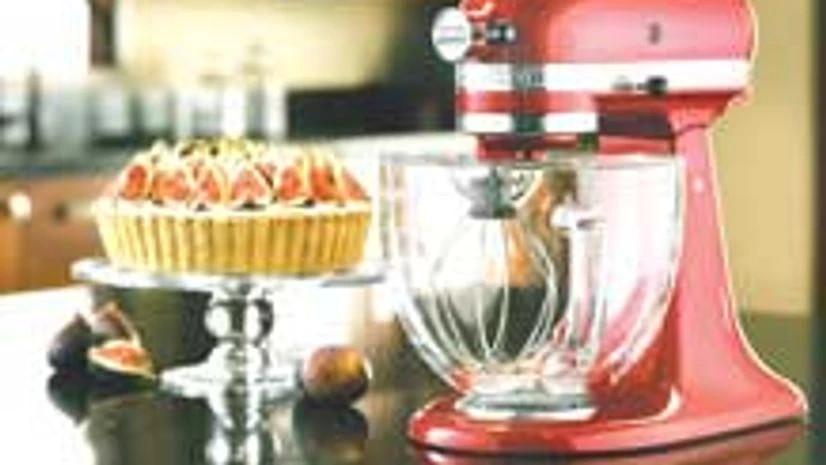Selling kitchen appliances has come a long way from the door-to-door salesmanship that sold the first Kitchenaid stand-mixers to American households in 1919. While the product's design has not changed since the 1930s, Mohit Jain, Kitchenaid's small appliances APAC regional director, has had to think up of ways to reach the Indian audience which has not seen the brand around for as long.
While parent Whirlpool had entered India much earlier, Kitchenaid, the US-based brand it had bought in 1986, was officially introduced only last October.
Yet, Jain does not want the brand, that has just launched its cordless stick blender, to fall into the wrong hands. "We don't want everyone buying it. We have to seed the brand right. Even with our latest blender, with its pricing (at nearly Rs 20,000), we are looking at 8,000-10,000 units in a year. It has to be first used by the involved, well-educated consumer."
Also Read
| Seasoned marketing |
|
Jain's insistence on the profile of the customer is echoed by other premium and luxury kitchen appliance brands as well, which sell at a premium between two and a half and 12 times the average product in the mass market. As a result, such brands are choosing unusual distribution channels to ply consumers with their ware.
Kitchen evangelists
Dhananjay Chaturvedi, managing director of Miele India, which operates in luxury kitchen appliances, draws on his decade-old stint earlier at LG to say, "When our customer walks into a durables store, she might be looking to replace a fridge or a TV. She is not looking for a major lifestyle choice but a logical purchase. For luxury appliances that cost seven to 12 times more, I need to be elsewhere." Hence, Miele which is into ovens, hobs, coffee machines, refrigerators and wine coolers, aims to catch the customer when she is looking to renovate or build a new kitchen. "When she walks into a modular kitchen brand's studio, she is willing to spend Rs 50 lakh on kitchen furniture and can look at spending Rs 2.5 lakh on Miele appliances. It will also build brand evangelism among the audience," says Chaturvedi. At the showrooms of Bulthaup, Hacker and Varrena Kitchens, Miele has more than 50 per cent share of display, according to Chaturvedi. It is also venturing into standalone stores.
Evangelism is on Jain's mind too: "In the first two-three years, we are going to get as many credible advocates as possible. Then we can get the rest of our global portfolio to India." Kitchenaid has gone in search of its advocates in gourmet food stores and specialty bakeware stores in metros. "Rather than be in a lot of places and shout, we need to be where people come in search of a certain blend of balsamic vinegar, for example. Foodhall gives us good conversion rates too, which is 1.5 times our average rate of conversions because of its upmarket locations," says Jain. Jain is also working to ensure that store executives at Future Group's gourmet chain, Foodhall, are able to tackle technical queries from consumers on baking. "Mass chain retailers have to worry about their return on inventory and our conversions also decrease in these," says Jain, though he is in talks with Croma. Online channels like its own site and Amazon bring in 20 per cent of sales (it sells around a few thousands of stand mixers).
Bosch, the German kitchen appliance brand in the mid-premium segment, is looking at more standalone stores, and has already opened a concept store in Bangalore, says Bhavya Shah, head of brand marketing, Bosch Home Appliances India. It is also evaluating the market to launch smaller appliances such as hand-blenders and mixers.
Luxury and premium kitchen appliance brands are also working with professionals in related industries to raise custom. While Kitchenaid regularly partners with chefs such as Vikas Khanna, the Michelin-starred Indian chef, for recipe books and product launches, Miele turns to interior designers and architects for recommendations (see box).
Product logic
Jain explains why Kitchenaid started with stand mixers even though it had more familiar products such as food processors and blenders. "I have drawn on lessons from heading APAC. Stand mixers are our flagship product. That is why we first got these to India, even though we are importing them and they cost upwards of Rs 40,000." He cites South Korea where Kitchenaid entered with a salad spinner. While it sold in 100,000s in three months, the audience unaware of the brand's lineage, came to associate it with salad spinners, one of its newer products. "I was clear that we would first stand for stand mixers here," says Jain. Kitchenaid would be bringing its major appliances such as ovens, refrigerators and customised products in 18-24 months, and launch food processors, stand blenders, coffee-makers before this Diwali.

)
